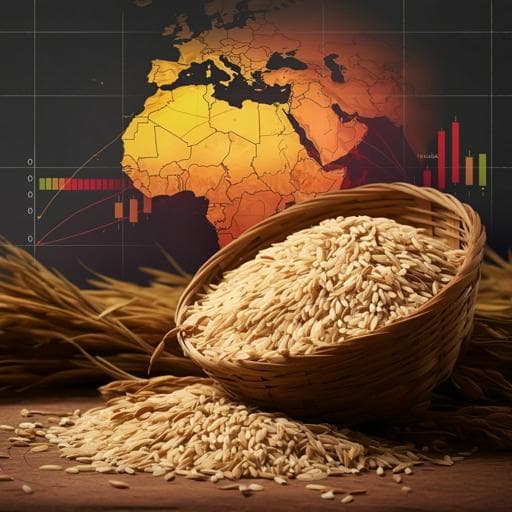
Agriculture
Rice availability and stability in Africa under future socio-economic development and climatic change
K. D. Vos, C. Janssens, et al.
Discover how socio-economic development shapes rice availability across Africa, as revealed in this compelling study by Koen De Vos, Charlotte Janssens, Liesbet Jacobs, and their colleagues. Their findings stress the importance of agricultural growth and trade facilitation in ensuring future rice stability amidst climate challenges.
~3 min • Beginner • English
Introduction
Rice demand in Africa has surged—quadrupling from about 10 Mt to 40 Mt between 1990 and 2018—driven by rapid population growth and dietary shifts. Despite yield advances, domestic rice production lags behind demand, leading to rising import dependence: up to 30% of rice is imported, primarily from Southeast Asia (17.8%) and India (12.0%). This import reliance heightens vulnerability to external supply and price shocks, exemplified by the 2008 food crisis. Domestic production is marked by high spatial and temporal yield variability, underdeveloped supply chains, and slow diffusion of higher-yielding varieties, contributing to uncertain supply and elevated food price volatility. With undernourishment at 21% in 2020, assessing future challenges from climate and socio-economic change for Africa’s food supply is imperative, with rice a key focus. The study seeks to integrate production, demand, trade, and variability to evaluate future rice availability and its temporal stability across Africa, examining the relative roles of socio-economic development, gradual climate change, and year-to-year climate anomalies.
Literature Review
Prior studies report mixed impacts of climate change on African rice yields due to differences in scale, scenarios, and assumptions. Van Oort and Zwart reported yield impacts ranging from −24% to +18% by 2070 and emphasized adopting heat-tolerant cultivars. Schleussner et al. predicted limited yield losses (<5%) in sub-Saharan Africa and highlighted CO2 fertilization. Gérardeux et al. projected rainfed yield losses in Senegal, partially offset by new cultivars, again stressing atmospheric CO2’s importance. Knox et al. found no significant climate impacts. Research on Africa’s indirect exposure through climate impacts in exporting regions is limited, despite the continent’s import dependence. Studies on climate-driven variability show increased year-to-year yield variability for wheat globally and for rice in Indonesia and the Philippines, but the implications for African rice yield variability and consumer response remain underexplored. Recent Shared Socio-economic Pathway (SSP) studies investigate combined socio-economic and climatic futures for agriculture globally but often omit yield variability, consumer response, and regional crop-specific analyses critical for policy.
Methodology
The study employs a sequential integration of a global gridded crop model (EPIC-IIASA) and a partial equilibrium economic model (GLOBIOM) to assess African rice availability and stability for the 2050s. EPIC-IIASA operates on a 5′ grid with daily inputs for radiation, temperature, precipitation, and humidity from five CMIP6 GCMs (GFDL-ESM4, IPSL-CM6A-LR, MPI-ESM1-2-HR, MRI-ESM2-0, UKESM1-0-LL), bias-corrected using GSWP3W5E5 v1.0. Simulations include forcing pathways SSP126 (well-below 2 °C) and SSP370 (high forcing, 7.0 W m−2 by 2100) with time-varying CO2 to capture fertilization effects; NoCC represents present-climate forcing without climate change. EPIC-IIASA yields for rice, wheat, maize, and soybean are calibrated to reproduce spatial yield patterns and interannual variability. GLOBIOM maximizes welfare every 10 years from 2000–2050, adjusting production, consumption, land use, and trade across 212,707 Simulation Units, allowing constrained land expansion/abandonment and management shifts among four systems (irrigated, high-input rainfed, low-input rainfed, self-subsistence). Demand is endogenously responsive to prices with exogenous population and GDP trajectories from SSP narratives; direct cross-price elasticities between crops are not modeled. Trade is modeled via spatial price equilibrium with nonlinear trade costs. Socio-economic narratives use SSP1 (Sustainability), SSP2 (Middle of the Road), and SSP3 (Regional Rivalry), capturing differences in population/GDP growth, technology, and trade barriers. Scenario matrix: 5 GCMs × 3 SSPs × 3 climate forcings = 45 combinations; ensemble projections aggregate GCMs to 9 combinations (3 SSPs × 3 forcings) enabling statistical inference from GCM spread. Potential yield at each decadal step is computed by scaling base-year yields (FAO 2000) by climatic and socio-economic factors; gradual climate effects for 2050 use 30-year means (2035–2065). Temporal variation is assessed within 2035–2065 using a percentile framework under two settings: (1) anomalies only (after linear detrending) and (2) anomalies plus trend (total variation). After the standard 2000–2050 run, an additional time step holds socio-economics constant and constrains land/management changes to mimic producers’ limited foresight, facilitating analysis of consumption responses to yield shocks (including p05 events) locally and in SEA and their spillovers across African regions.
Key Findings
- Socio-economic development is the primary driver of African rice availability by 2050; climate change exerts comparatively minor long-term effects on availability.
- Climate change is projected not to amplify supply shocks in most African regions; magnitudes of consumption responses to p05 yield shocks under SSP126 or SSP370 generally are not significantly different from NoCC for many regions (e.g., AMU, ECCAS, RCEAF, SACU).
- Sensitivity to local anomalies remains high in rainfed-dominated regions (e.g., ECOWAS, EAC) and in self-sufficient or near-self-sufficient regions (e.g., RSouthAf, Egypt); import-dependent regions (e.g., AMU, SACU) show minimal local shock effects but higher vulnerability to foreign shocks.
- Local yield shocks (diagonal in shock–response matrix) cause larger consumption drops than intracontinental spillovers (off-diagonal), indicating limited spillover across African regions.
- External shocks from Southeast Asia (SEA) can reduce African consumption, with impacts proportional to import dependence; in some import-reliant regions (AMU, RCEAF), SEA shock-induced consumption drops can exceed those from local shocks.
- Under SSP126, consumption drops from SEA shocks are systematically smaller in most African regions than under NoCC, suggesting mitigation of trade-propagated shocks at lower forcing levels; under SSP370, SEA shock impacts are not significantly different from NoCC.
- Across SSP narratives, differences in consumer response magnitudes are modest; however, the SEA-shock response is generally lowest under SSP1 (least trade barriers).
- Temporal variation in per capita consumption (2035–2065) is substantial across regions and SSPs; including trends increases variation relative to anomalies-only. Local yield variability affects both lower and upper tails of consumption distributions, while SEA variability primarily affects lower tails (downside risk via trade).
- Market-mediated adjustments (imports, area expansion, management shifts) largely compensate gradual climate productivity losses, limiting long-run availability impacts.
- Contextual data: Africa currently imports ~30% of rice (17.8% from SEA, 12.0% from India); undernourishment prevalence was ~21% in 2020.
Discussion
The integrated modeling shows that Africa’s future rice availability is dominated by socio-economic trajectories—population growth, income, technology, and trade policies—rather than by climate forcing. Market responses in GLOBIOM (land reallocation, management shifts, and trade) buffer gradual climate impacts, resulting in smaller availability changes than some single-model agronomic studies suggest. Stability analysis indicates that climate change does not generally intensify the magnitude of consumption shocks relative to historical variability, but structural vulnerabilities persist: rainfed systems and highly self-sufficient regions remain sensitive to local shocks due to precipitation dependence and limited buffering through trade. While variability in precipitation may increase, predicted consumer responses do not necessarily rise, suggesting opportunities to enhance resilience through irrigation where sustainable, productivity growth, and improved market integration. Import-dependent regions are more exposed to foreign shocks, particularly from SEA; lowering atmospheric forcing (SSP126-like pathways) and limiting trade barriers can reduce the magnitude of trade-propagated consumption drops. These findings inform policy by prioritizing socio-economic development (technology diffusion, infrastructure, finance) and open, diversified trade over strict self-sufficiency, while recognizing constraints and the need for targeted adaptation in rainfed systems.
Conclusion
This study introduces an integrated framework combining EPIC-IIASA and GLOBIOM to jointly assess availability and temporal stability of rice in Africa under combined socio-economic and climatic futures. Results highlight that socio-economic development governs rice availability to 2050, while climate change has limited long-run effects and is not projected to amplify supply shocks. Stability remains influenced by local production variability in rainfed and self-sufficient regions, and by trade-mediated exposure in import-dependent regions. Policy implications include prioritizing agricultural productivity growth, sustainable irrigation where feasible, storage capacity upgrades, diversified trade networks, and minimized trade barriers to reduce vulnerability to both local and external shocks. Future research should refine consumer response estimates by incorporating cross-price effects and within-country spatial population dynamics, improve representation of extreme event impacts in crop models, and extend the framework to other commodities and regions.
Limitations
- Economic model limitations: GLOBIOM does not include direct cross-price substitution between crops, potentially underestimating demand-side adjustment and consumer response heterogeneity. Decadal time steps limit resolution for short-term dynamics; an additional constrained step approximates intra-decadal variability.
- Crop model limitations: Global crop models (including EPIC-IIASA) may underestimate yield responses to droughts and heatwaves; responses to rare extremes are difficult to capture. Management adaptation such as cultivar changes and sowing date shifts are not explicitly modeled in GLOBIOM.
- Scenario constraints: Only SSP1–3 socio-economic narratives and NoCC/SSP126/SSP370 forcing pathways are considered; results rely on ensemble averages of five GCMs. CO2 fertilization is included, but uncertainties remain in its magnitude.
- Scope: Analysis centers on rice; although other crops are modeled for land allocation, broader diet substitution effects and price feedbacks across foods are not fully captured.
- Generalizability: Results provide first-order indications rather than precise estimates of consumer responses and stability; local water availability and feasibility limit irrigation expansion potential, requiring localized assessments.
Related Publications
Explore these studies to deepen your understanding of the subject.







